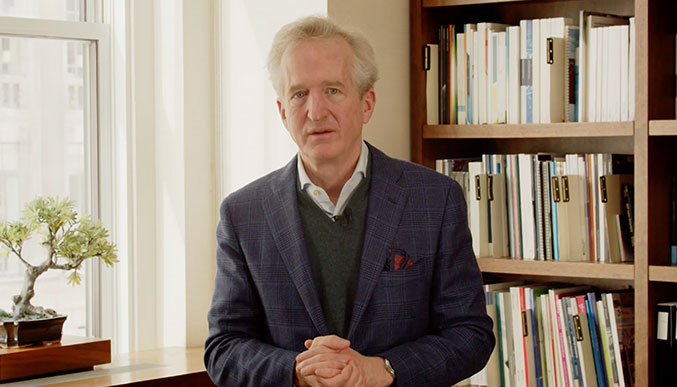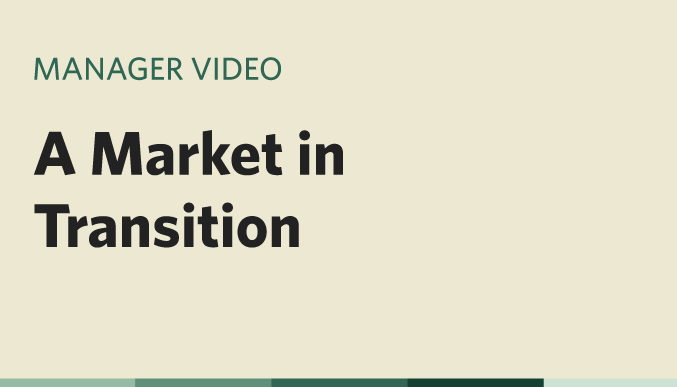PM Chris Davis on the big technological and market transitions unfolding – and the advantages our investment discipline has in this environment
Transcript
Chris Davis: One of the great sources of satisfaction of being in this profession for so long is the relationship and we've built with many of the advisors who have trusted us with their, with their client savings over the decades. And one of the reasons we wanted to make this video is because we're so, excited about our positioning in this current environment as so many of the headwinds that we faced over the last decade in an era of zero cost money, of free money and magical thinking, as many of those headwinds have become tailwinds So we wanted to give a little bit of a background about the market backdrop, the economic backdrop, and also some specific characteristics about the portfolio that underlie our conviction in the decade ahead.
The Era of Magical Thinking and Free Money
The market period that began after the financial crisis in 2008-2009 really marked more than a decade that had been unprecedented really in all of recorded history. It was a period of time where the cost of money, as measured by interest rates, approached zero and the result of that were these incredible distortions. We call it a time of magical thinking, where the government could print money without any consequences to interest rate where inflation approached zero because prices were artificially held down and interest rates were held down. Now, in that period of time, evaluation discipline like ours was sort of out of sync with that environment, because we invest with the idea that money has a cost. We use a discounted present value methodology. That was completely out of favor. So we built wealth for shareholders and our results relative to the typical value investor were good and durable during that period of time. But the S&P index galloped ahead driven by narrower, narrower concentration, higher and higher valuation, and more and more speculation. So it was a time where value discipline was out of fashion, and at time when it was important to stick to the discipline, even though it was out of a sync with what was going on in this era of free money and magical thinking.
The era of magical thinking came to a close in March of 2022, and that's when the Federal Reserve finally began to acknowledge what we all knew was happening. That there was enormous inflationary pressure underneath and that this model of free money was not sustainable. So interest rates started going up and the cracks began to show in the system. Now this was the environment we had been anticipating for years and we felt absolutely well-prepared and well-positioned as these cracks began to widen.
Types of Business We Think Investors Should Own Today
One of the most striking things about the environment of transition that we're moving through, that involves economic transition, it revolves changes in interest rates, monetary policy, inflation, technological disruption, geopolitical instability, as you look at that array of risk it is so important to focus on the fundamental strengths of the types of businesses you own. You want to own businesses that can make headway through these uncertain times.
So, our focus on the fundamentals, we think, matters more than ever today. So, what sorts of characteristics do we think about? Well, let's start with balance sheet strength. Let's start with durable business models. Business models that aren't so prone to the disruption that is rolling through the system as a result of breakthroughs in technology. Let's think about businesses that aren't economically fragile, that are able to go through periods of dislocation, shocks, booms and busts.
Management teams that have been proven over time that have the ability to adapt, have proven records of advocating and representing their shareholders, but also resisting the fads and the bubbles. So, in other words, durable businesses with strong balance sheets, proven management teams that are able to grow over the long period of time, not necessarily in a straight line, not the hyper growth darlings either, but rather durable, resilient growth that can be purchased at attractive prices.
A central tenet of our investment discipline is our valuation discipline. And what that means is that when we own a business, we want to own businesses that are producing a lot of cash, not at some distant point in the future that may be vulnerable to changes but rather that are producing a lot of earnings today because that earnings today reinforces their resilience and that was not fashionable when money was free and always available but as things have tightened that valuation discipline matters more and more both because of the economics it produces to today but also because of the resilience that is built into those sorts of business models.
Today’s Investment Themes
As we think about risks and uncertainty in the environment, it's amazing how important the durability of a business model is. So when we think about themes that manifest in the portfolio, durability is one that runs through all of the sectors that we are attracted to in this environment. So let's look at some of those themes. Well, what's one of the oldest business models there? Of course, it's banking, it's making a spread on money. And what's interesting is that financial companies have been out of favor for so long that we can buy some of the best and strongest financial companies on Earth at really attractive valuations. And so we've seen them power through uncertainty, we see record low valuations, and yet they've demonstrated through COVID, through the commercial real estate shocks, their enormous resilience and durability. So, we think financials represent a terrific sector, balancing risk and reward, durability and growth and low valuations.
Now, what's the second sector? Well, if we were to say technology, people think, oh, well, that's what's sort of in bloom today. What is it that we see? And the answer is within technology, we're focusing on those companies that have proven business models that generate enormous earnings today, but also have enormous moats around their business. So the risk in technology is people often overpay for growth, or they underappreciate how disruptable so many technology businesses have been. So we're very selective in focusing on those companies where we think they have a durable proven business model. They generate an enormous amount of cash today and have management teams that have been able to guide them through periods of disruption.
Now, a third theme is always been around healthcare, right? We know that healthcare is a growing segment. It's driven by demographics. It's driven by technological breakthroughs. It's driven by innovation. It's driven by this aging population. And yet because it can be a favored sector, once again, people will often overpay for the growth darlings. Within healthcare, we're looking for durability and resilience. So we tend to look for companies that are not price takers, but really value creators in the systems. Think of lab companies, think of service companies. Those are the sorts of things that we think about within the healthcare sector.
And finally, as a theme, I give a sort of a catch-all theme, which is what we would call select growing industrials. Now, the nature of an industrial business is that, unlike a consumer companies, its earnings Things might not always grow in a perfectly linear way. They may have some economic sensitivity, but within those sectors there are companies that have been able to grow not just for years, but for decades. But because those earnings aren't always linear, if we're careful we can buy really growth companies that are trading at depressed or cyclical valuations. So we think of these as resilient industrial companies that have the characteristics of good, durable growth at a low valuation.
A Portfolio Positioned to Help Investors Build Wealth
When we make the case to our long-term shareholders and clients about why we are so optimistic and well positioned for the decade ahead, it's because the portfolio at this moment combines two very unusual characteristics.
The first is that we have a group of companies that have been able to grow at or above the market averages in terms of their earnings. And yet by being selective, we've been able to build that portfolio at valuations that are 30 to 35 percent below the market averages. So growth and low valuations, we call that a value investor's dream. And that's really the reason that we feel so well positioned and so optimistic about the decade ahead.
Related Videos
Positioning for a Market in Transition
PM Chris Davis on Today's Markets and Davis LCV SMA
The Most Important Things We Believe Equity Investors Should Focus on Today (6:07)
Why we believe selectivity is more important in a time of great market and economic transition and highs in both market concentration and valuations

